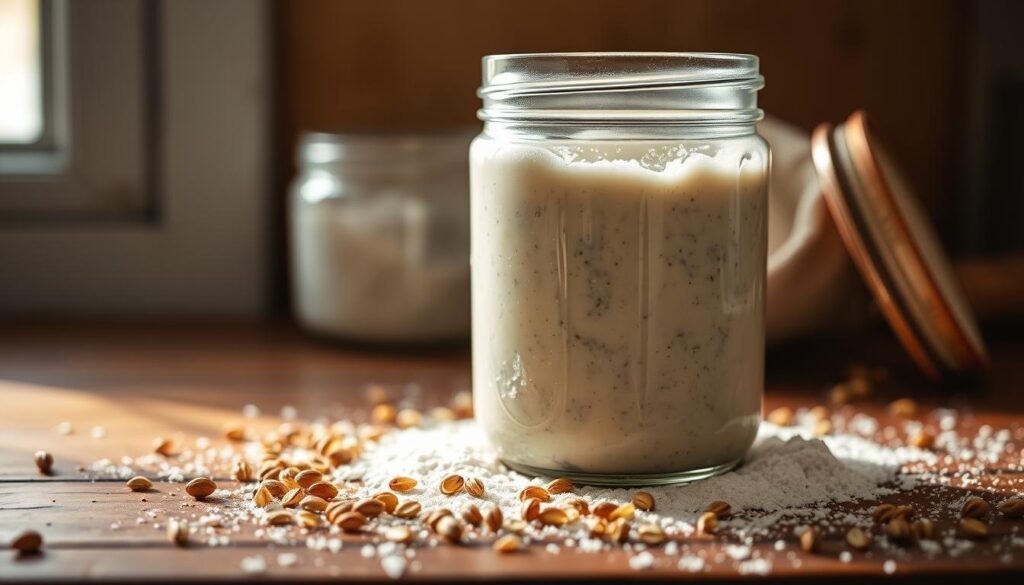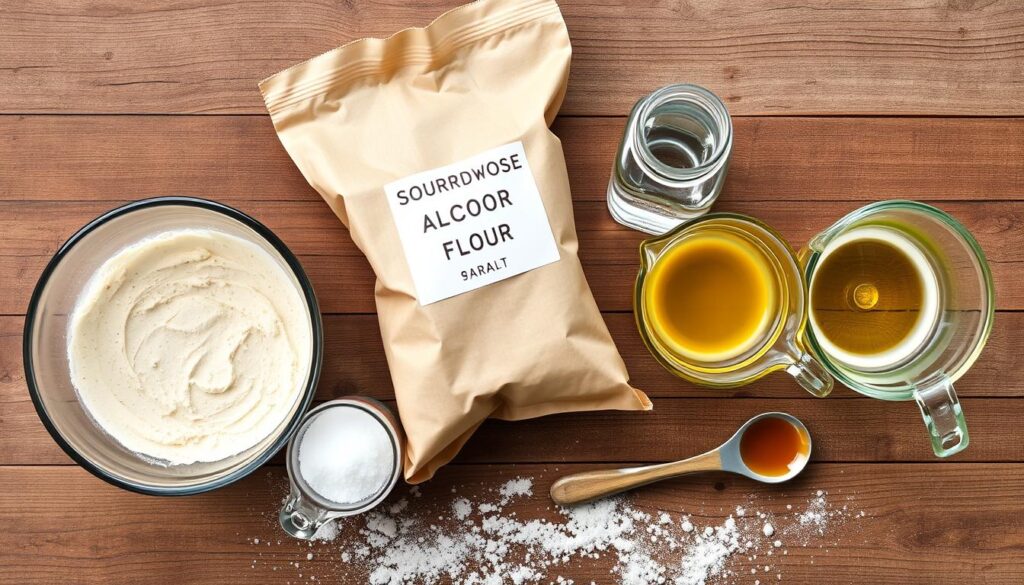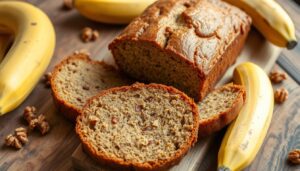As a busy parent, baking homemade bread can seem like a big challenge. But, you can make a soft, fluffy sourdough sandwich loaf at home. This recipe is easy and lets you enjoy the taste and texture of artisanal bread without the fuss.
The smell of fresh bread always made our home cozy when I was growing up. Now, I love sharing this joy with my family. Making sourdough sandwich bread from scratch might look hard, but this guide makes it simple. You’ll be making loaves like a pro in no time.
Table of Contents
Key Takeaways
- Easy sourdough sandwich bread recipe with a soft, fluffy texture
- Detailed instructions for mixing, shaping, and baking the perfect loaf
- Utilizes a simple sourdough starter for authentic flavor
- Versatile recipe that can be enjoyed for sandwiches, toast, and more
- Homemade bread made easy with just a few basic ingredients
Get ready to wow your family and friends with this sourdough sandwich bread. Let’s get started and make a true artisanal masterpiece in your kitchen.
What is Sourdough Sandwich Bread?
Sourdough sandwich bread is a homemade treat that uses a sourdough starter for rising. It has a richer taste and a chewy, airy texture. The starter, made from flour and water, adds a tangy flavor.
Sourdough Starter: The Backbone of Homemade Sourdough Bread
The sourdough starter is the core of sourdough sandwich bread. It’s a mix of wild yeasts and bacteria that makes the bread special. By adding the starter to the dough, bakers get a loaf that’s full of flavor and has a great texture.
The starter does more than just help the dough rise. It also adds to the bread’s artisan quality. As the dough ferments, the starter brings out complex flavors, turning simple ingredients into a remarkable loaf.

“The sourdough starter is the heart and soul of homemade sourdough bread. It’s what gives the bread its unique flavor and texture, making it a true artisanal delight.”
Whether you’re a seasoned baker or new to sourdough, knowing about the sourdough starter is key. It’s essential for making delicious sourdough sandwich bread at home.
Ingredients for Sourdough Sandwich Bread
Making sourdough sandwich bread at home is easy with just a few key ingredients. The heart of this bread is an active sourdough starter. It makes the bread light and tangy. You also need all-purpose flour for structure and a soft crumb, and water to keep the dough moist.
Olive oil adds richness and a crispy crust. Honey makes the bread sweeter and gives it a golden color. A bit of salt balances the taste and makes the bread chewy.
Essential Ingredients and Their Roles
- Sourdough Starter: The living, fermented dough that acts as the primary leavening agent, responsible for the bread’s rise and distinctive tangy flavor.
- All-Purpose Flour: Provides structure and a tender crumb to the bread.
- Water: Hydrates the dough, allowing the gluten to develop and the yeast to activate.
- Olive Oil: Adds richness and helps create a crisp, golden-brown crust.
- Honey: Enhances the bread’s sweetness and encourages browning during baking.
- Salt: Balances the flavors and strengthens the gluten structure, resulting in a chewy, well-risen loaf.
Each ingredient is crucial for making a tasty, homemade sourdough sandwich bread. It’s great for avocado toast or grilled cheese.

Tools Needed for Sourdough Bread Baking
To bake tasty homemade sourdough sandwich bread, you need a few key tools. A stand mixer with a dough hook attachment is very helpful. It kneads the dough quickly, saving you time and effort. But, you can also mix and knead by hand if you don’t have a stand mixer.
A Danish dough whisk is also useful. It helps mix all the ingredients and develop the dough’s gluten. A metal bench scraper is great for shaping the dough and putting it in the loaf pan.
Lastly, a 9×4-inch loaf pan with straight sides is essential. It’s the perfect size for baking your sourdough sandwich bread. With these tools, you’ll be ready to bake with confidence.
- Kitchen scale for accurate ingredient measurement
- Mixing bowls in stainless steel, glass, or ceramic
- Dough scraper for mixing, shaping, and cleaning surfaces
- Proofing baskets or DIY versions for shaping dough
- Parchment paper for lining baking surfaces
- Bread knife for slicing the finished loaf
- Oven mitts for handling hot pans
- Steaming tool to create a crisp crust
With these basic tools, you’re ready to bake delicious homemade sourdough sandwich bread in your kitchen.
Step-by-Step Process for Making Sourdough Sandwich Bread
Making sourdough sandwich bread at home is a fun and rewarding task. It involves a few important steps. Let’s explore sourdough dough mixing, sourdough dough stretching, sourdough dough proofing, and sourdough dough shaping.
Mixing and Stretching the Dough
Start by mixing your active sourdough starter with warm water, olive oil, and honey. Then, add all-purpose flour and salt slowly. This will create a shaggy dough.
Let the dough rest for 45 minutes. Then, knead it until it’s smooth and elastic. You can do this by hand or with a stand mixer.
The dough needs to be stretched and folded several times during the first rise. This rise lasts about 8-12 hours at room temperature.
Proofing and Shaping the Loaf
Once the dough has risen, shape it into a loaf. Place it in a greased bread pan. Let it proof for a second time, either at room temperature or in the fridge, for 30 minutes to 2 hours.
This second proofing makes the dough soft yet sturdy. It’s perfect for slicing and making tasty sourdough sandwiches.
Baking the Sourdough Sandwich Bread
Baking the perfect sourdough sandwich bread is key. It needs a crisp, golden crust and a soft inside. Start by spraying the dough with water in the loaf pan. This creates steam in the oven, helping the crust.
Put the pan in a hot oven and spray water in it now and then. This keeps the steam going. Bake for 35-45 minutes, until the crust is dark and the inside is 205-210°F. Let the loaf cool completely before slicing for the best texture.
Adding a bit of milk powder to the dough makes it even softer. Baking to 190-200ºF (88-93ºC) is also good. Using an 8.5″x4.5″ loaf pan or a Pullman pan helps the bread rise evenly.
The secret to great sourdough bread is keeping the right temperature and humidity. With practice, you’ll make delicious bread every time. It will have a perfect crust and a soft inside.
Sourdough Sandwich Bread Storage Tips
Keeping your homemade sourdough sandwich bread fresh is key. To ensure it stays soft and delicious, follow these easy storage tips:
For short-term storage, place the cooled bread in an airtight container or bag. This keeps it fresh for up to 3 days. Sourdough bread stays fresh longer than regular bread, thanks to its natural fermentation.
To make it last even longer, slice and freeze the cooled loaf. Frozen sourdough can stay good for up to 2 months. Just thaw and toast the slices to get that fresh-baked taste and feel.
Don’t store sourdough bread in the fridge. The dry air can make it stale faster. Instead, keep it in a cool, dry place at 60-70°F. The bread’s freshness can be affected by humidity, so adjust your storage as needed.
By using these sourdough bread storage tips, your homemade sourdough sandwich bread will stay fresh and tasty. This way, you can enjoy it for longer, reducing waste and savoring every bite of this artisanal treat.
Soft Sourdough Sandwich Bread Recipe
Indulge in the simple pleasure of homemade sourdough sandwich bread. It’s soft, fluffy, and perfect for toast, sandwiches, and more. This recipe yields a loaf with a crisp crust and a light, airy crumb. Get ready to savor the tantalizing flavors and aromas of freshly baked homemade sourdough bread.
The key to this soft sourdough sandwich bread is the active sourdough starter. It serves as the leavening agent. Combined with all-purpose flour, water, olive oil, honey, and salt, the dough undergoes stretch and fold cycles. After the initial rise, the shaped loaf proofs until it’s ready to be baked in a hot oven with steam. This results in a beautiful, bakery-quality loaf.
- In a large bowl, combine 150g (3/4 cup) of active sourdough starter, 300g (1 1/4 cups) of warm water, 40g (2 Tablespoons) of honey, and 57g (4 Tablespoons) of melted unsalted butter.
- Gradually add 125g (1 cup) of whole wheat flour and 375g (2 2/3 cups) of bread flour, along with 9g (1 1/2 teaspoons) of salt. Mix until a shaggy dough forms.
- Turn the dough out onto a lightly floured surface and knead for about 10 minutes, or until the dough becomes smooth and elastic.
- Place the dough in a lightly greased bowl, cover, and let it rise for 10-12 hours at 70°F, or until it has doubled in size.
- Punch down the dough to release air bubbles, then shape it into a loaf and place it in a greased 9×5-inch bread pan.
- Cover the pan and let the dough rise for another 3-6 hours, or until it has domed about 1-2 inches above the rim of the pan.
- Preheat your oven to 375°F. Bake the bread for 45 minutes, then remove the foil and bake for an additional 5-10 minutes, or until the crust is golden brown.
- Allow the bread to cool completely on a wire rack before slicing and serving.
Enjoy the soft, delicious texture and rich, tangy flavor of this homemade sourdough sandwich bread. Whether you’re making it for breakfast, lunch, or a snack, this recipe is sure to impress and satisfy.
Sourdough Sandwich Bread Troubleshooting
Baking the perfect sourdough sandwich bread is a delicate task. It mainly depends on managing your kitchen’s temperature and humidity. If you’re facing issues with your dough rising or the final loaf, we’ve got tips to help.
Adjusting for Different Kitchen Temperatures
The temperature and humidity in your kitchen can affect your sourdough bread. In cooler kitchens (below 68°F/20°C), the dough may take longer to rise. To speed up, use more active sourdough starter.
In warmer kitchens (above 72°F/22°C), the dough rises too fast. This can make the loaf over-proofed. Keep an eye on the dough and adjust the proofing times to get the best results.
The ideal temperature for sourdough dough to rise is 68-72°F (20-22°C). By adjusting your process based on your kitchen’s conditions, you can make perfect sourdough sandwich bread every time.
Benefits of Homemade Sourdough Bread
Making your own sourdough sandwich bread at home has many perks. It’s made with simple, quality ingredients, unlike commercial breads. The sourdough process also boosts the bread’s nutritional profile. This makes it easier to digest and better for those with gluten issues.
Baking bread can be a calming, rewarding activity. It connects you to the art of artisanal baking. Enjoying fresh, homemade sourdough sandwich bread is a simple joy that’s both nourishing and satisfying.
- Sourdough bread uses natural yeasts for rising, appealing to those who follow ancestral eating.
- It’s made with just flour, salt, and water.
- Its glycemic index of 54 is lower than regular bread, affecting blood sugar less.
- The fermentation process removes phytate, making nutrients more available.
- Sourdough is good for gut health because it breaks down phytic acid, aiding digestion.
- It might be okay for people with gluten issues, depending on their sensitivity and the bread-making process.
| Nutrient | Amount per 50g serving |
|---|---|
| Calories | 130 |
| Protein | 4g |
| Fat | 1g |
| Carbohydrates | 25g |
| Fiber | 1g |
| Sugar | less than 1g |
| Sodium | 200-300mg |
Sourdough bread is packed with nutrients, has a lower glycemic index, and more soluble fiber. This supports gut health. The fermentation process also reduces gluten, making it easier to digest for those with gluten sensitivities.
“Whole-grain sourdough bread is considered the healthiest option due to its higher fiber, protein, and micronutrient content.”
In conclusion, homemade sourdough sandwich bread offers more than just great taste. It’s better for you, from its nutritional benefits to its digestibility. Baking your own sourdough at home is a rewarding and nourishing experience.
sourdough sandwich bread
Sourdough sandwich bread is a special twist on regular white bread. It has a complex, tangy taste and a soft, airy texture. This makes it great for sandwiches, toast, and more. The secret is using a sourdough starter as the leavening agent.
Sourdough starters are made from wild yeast and beneficial bacteria. They give the bread a unique flavor. This makes the bread not only tasty but also healthier, as the fermentation process breaks down starches and gluten.
By baking sourdough sandwich bread at home, you control the ingredients. You use high-quality flour, water, and other components. This makes it a healthier and more satisfying choice than store-bought bread, which often has additives and preservatives.
Whether you’re experienced or new to artisan bread, making a sourdough loaf is rewarding. With the right techniques and tools, you can make amazing sourdough sandwich bread at home. Your kitchen will fill with the aroma of freshly baked bread.
“Sourdough bread is a true labor of love, but the results are well worth the effort. The depth of flavor and the satisfying texture make it a staple in my kitchen.”
Serving Suggestions for Sourdough Sandwich Bread
Sourdough sandwich bread is very versatile. You can slice it thin for classic sandwiches. Add your favorite meats, cheeses, and condiments.
Toasting thick slices makes great breakfast avocado toast or bruschetta. You can also make delicious grilled cheese or French toast. Even cube the bread for a tasty stuffing or bread pudding.
The tangy, chewy texture of sourdough sandwich bread goes well with both sweet and savory toppings. It’s perfect for any meal, from simple lunches to fancy brunches. This bread is sure to impress everyone.
- Sandwiches: Layer thin slices with deli meats, cheeses, lettuce, tomatoes, and your favorite condiments.
- Toast: Toast thick slices and top with avocado, scrambled eggs, or bruschetta.
- Grilled Cheese: Create gooey, melty grilled cheese sandwiches with your choice of cheeses.
- French Toast: Dip slices in a custard-like egg mixture and pan-fry for a decadent breakfast treat.
- Stuffing: Cube the bread and bake it into a savory stuffing or bread pudding.
No matter how you serve it, sourdough sandwich bread will make your meals better. Try different toppings and ways to serve it. You’ll find your new favorite way to enjoy this bread.
“Sourdough bread is the perfect canvas for both sweet and savory toppings. Its slightly tangy flavor and chewy texture make it a versatile and delicious choice for any meal.”
Conclusion
Learning to make sourdough sandwich bread at home is very rewarding. It lets you create a loaf with a special flavor and texture. This is much better than what you can buy.
With the right ingredients and tools, you can make top-notch sourdough sandwich bread at home. This recipe is easy to follow and will become a favorite in your kitchen.
Enjoy your homemade sourdough bread on toast, in sandwiches, or as a side dish. The process of artisanal bread baking is fun and delicious. This guide has given you the knowledge to make amazing sourdough sandwich bread. Now, you can take your cooking to the next level.
F.A.Q
-
What is sourdough starter and how does it contribute to the bread?
A sourdough starter is a mix of flour and water that ferments over time. It has natural yeasts that make the dough rise and give it a tangy flavor. This starter is key to making sourdough bread, adding leavening power and artisan quality.
-
What are the key ingredients for making sourdough sandwich bread?
The main ingredients are active sourdough starter, all-purpose flour, water, olive oil, honey, and salt. The starter leavens the bread. The other ingredients help with structure, flavor, and texture.
-
What essential tools are needed for baking sourdough sandwich bread at home?
You’ll need a stand mixer with a dough hook, a Danish dough whisk, a metal bench scraper, and a 9×4-inch loaf pan. These tools help with mixing, kneading, shaping, and baking.
-
How do you store homemade sourdough sandwich bread to keep it fresh?
To keep the bread fresh, store it in an airtight container or bread bag at room temperature for up to 3 days. For longer storage, slice the cooled bread and freeze it for up to 2 months.
-
How can you adjust the recipe for different kitchen temperatures?
In cooler kitchens (below 68°F/20°C), use more active starter to speed up rising. In warmer kitchens (above 72°F/22°C), watch the dough closely to avoid over-proofing. Adjust proofing times as needed.



